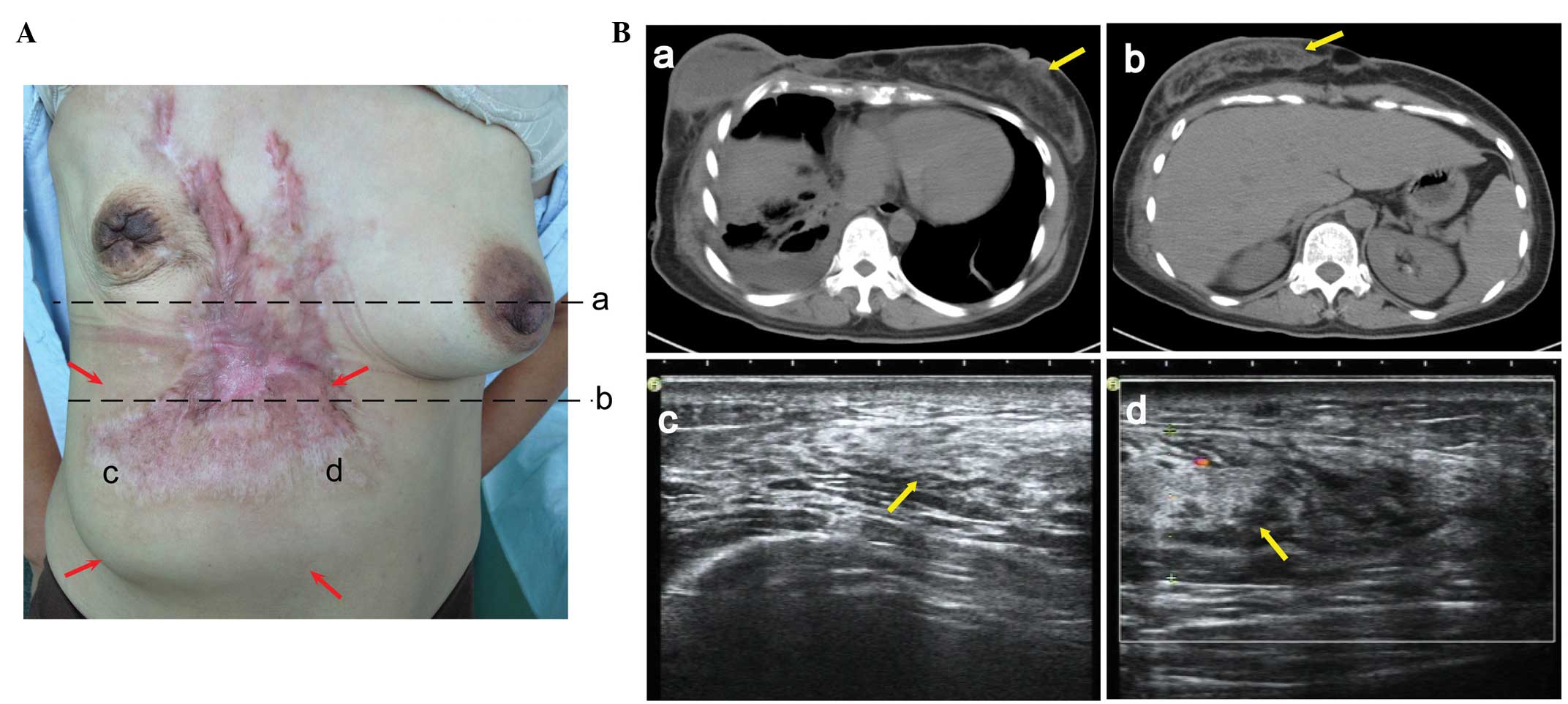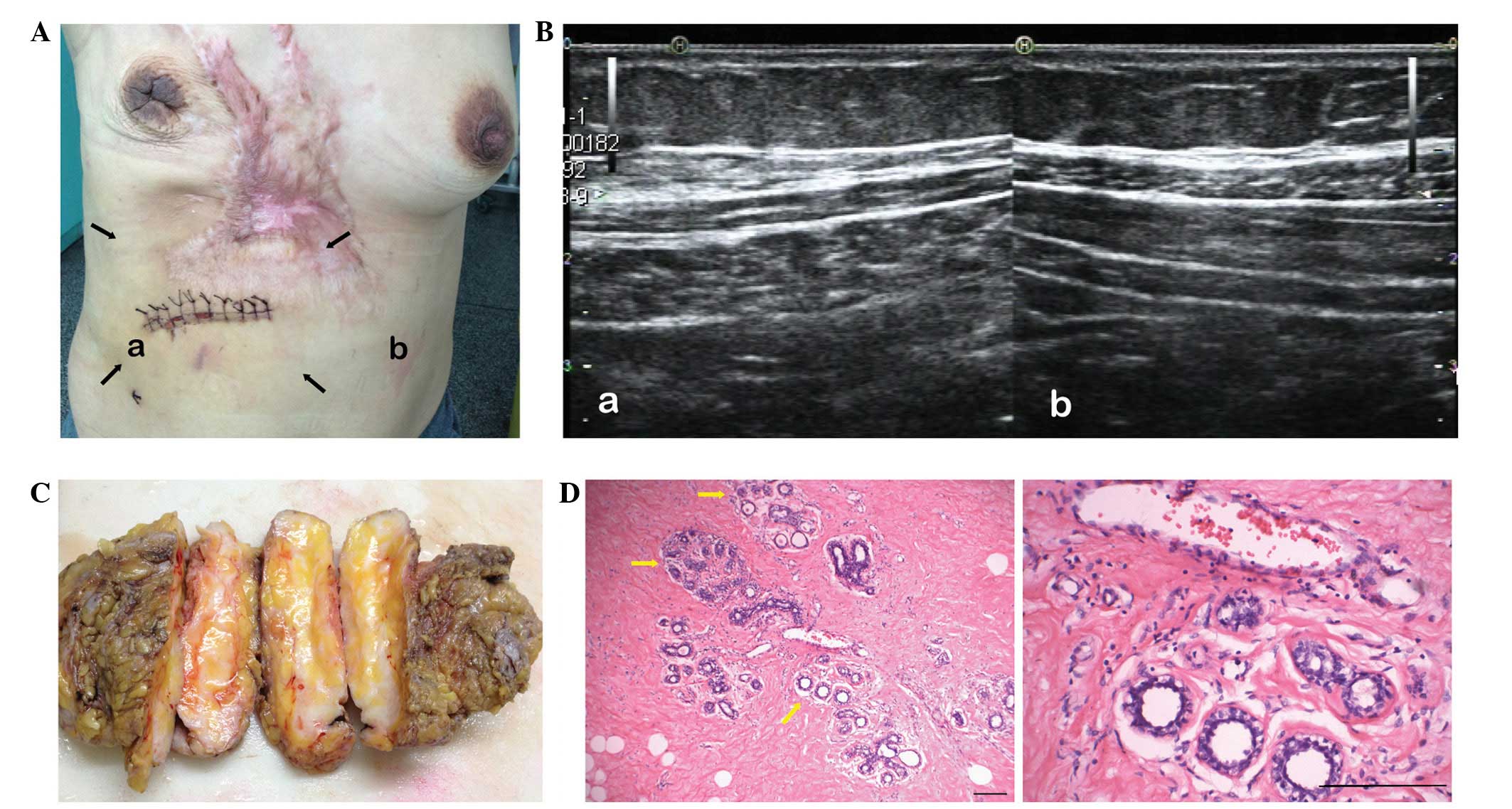Introduction
Breast transposal/transplantation is rarely
reported. Due to the increased use of mastectomy, much effort has
been focused on breast reconstruction, including the use of
adipose-derived stem cells (ASC) (1). Studies have used ASC for breast
reconstruction (2) and augmentation
(3). ASC assisted techniques can
achieve satisfactory outcomes for breast augmentation (3,4), and
Ribuffo et al (5) has
reported the technique of lipofilling with ASCs following
irradiation on the fill expander. However, to date, no encouraging
results have been reported with regard to total breast
reconstruction. The survival of foreign tissue or organs is
difficult and therefore, tissue or organ transposal is rarely
performed. In particular, transposal of an abdominal wall mass is
an extremely rare event. Mammary gland transposal caused by blunt
force has not been previously reported in the literature.
Generally, when subjected to a powerful force, such as being hit by
a car, and obtaining serious injuries to the chest wall, the breast
may exhibit significant damage and necrosis. Even if the breast
shifts to another position, without an adequate blood supply, the
breast could not survive. Therefore, when normally confronted with
an abdominal wall mass, a transposed breast would not be expected.
Notably, in the present unique case, the force of a pedestrian
traffic accident was sufficient to shift the mammary gland to the
abdomen, where it grew healthily for 6 months in its new
location.
Case report
In July 2013, a 40-year-old female presented to the
Breast Center, General Hospital of Guangzhou Military Command of
the People’s Liberation Army (Guangzhou, China) with an unusual
post-traumatic mass in the right abdominal wall was admitted by our
department. The medical history was only notable for a car accident
that had occurred 6 months earlier. In that car accident, the
patient was provided with thoracic surgery to treat the rib
fractures and lung injury. Following this, the patient was admitted
to the Breast Center, General Hospital of Guangzhou Military
Command of the People’s Liberation Army due to the sudden onset of
a protruding mass on the right abdominal wall, which was indicated
to be breast tissue by CT imaging. Upon examination, the right
mammary gland was missing from its normal position, leaving a
nipple areola complex on the right chest (Fig. 1A), and a mass ~11×15 cm in size was
apparent in the right upper abdominal wall (Fig. 1A). This was further viewed by chest
CT and ultrasound scans. The CT scan showed no right mammary gland
on the right chest wall (Fig. 1Ba),
but a mammary gland image of normal appearance was present in the
right upper quadrant of the abdomen (Fig. 1Bb). Moreover, the ultrasound scan
also indicated that the protruding mass on the abdominal wall was a
mammary gland (Fig. 1Bc and d).
Reversion of the transposed breast to its original
position was planned, however, the patient requested that it be
removed. Therefore, a resection of the mass was performed resulting
in complete removal of the transposed mammary gland (Fig. 2A and C). Following surgery, an
ultrasound scan was performed again to ensure complete resection of
the mass (Fig. 2B). The
pathological diagnosis confirmed that the resected mass consisted
of normal breast tissue (Fig. 2C and
D) without notable necrosis. One month later, the patient
returned for a follow-up examination, which showed that the
abdominal wound had healed well. Consent was obtained from the
patient for publication of this case study.
Discussion
The most commonly reported tissue/organ transposals
or transplantations include allogeneic hematopoietic stem cell
transplantation to treat patients with hematopoietic cancer
(6), autologous stem cell
transplantation to treat liver volume expansion in patients with
extensive hepatectomy (7), and
allogeneic liver or kidney transplantations to treat end-stage
liver (8,9) or kidney (10,11)
disease. However, these procedures are performed manually, are
complex and may cause complications, such as immune rejection. In
addition, the tissue or organ is placed in the same position as its
origin, providing a desirable environment for survival. Notably,
the transplantation of ectopic pancreas tissue was reported by Endo
et al (12) in Japan, which
involved the removal of the tissue from its origin to a different
environment. However, an adenocarcinoma arose from the ectopic
pancreas tissue. Therefore, the survival of a normal ectopic
organ/tissue is a rare event. To date, no whole breast
transplantations have been reported, possibly due to the rare
survival of ectopic normal organs/tissue.
Breast transposal is a rare condition, however, the
present case study describes an original and unique case. In a
traffic accident that occurred 6 months prior to admittance, the
patient was hit by a car and thrown a large distance, resulting in
multiple right rib fractures and lung injury. However, even
following such as powerful impact, the right breast was not
significantly damaged, and only the mammary gland shifted to the
abdomen. This grew normally for ~6 months until the patient was
admitted to the Breast Center, General Hospital of Guangzhou
Military Command of the People’s Liberation Army. Even when
considering the wide range of serious injuries that can occur to
the chest wall, it is noteworthy that the patient developed a
healthy transposed breast in the abdomen following such a severe
trauma to the right chest. This case highlights the capability of
the mammary gland to withstand a powerful impact and survive. This
case suggests that breast transplantation may be possible in the
future and also advances our knowledge of the manner in which
mammary tissues respond to severe blunt-force impact by emigrating
to a new location and surviving.
Acknowledgements
This study was funded by grants from the National
Natural Science Foundation of China (nos. 81202076 and 81371004)
and the Guangdong Natural Science Foundation (no.
S2013010012048).
References
|
1
|
Philips BJ, Marra KG and Rubin JP: Healing
of grafted adipose tissue: current clinical applications of
adipose-derived stem cells for breast and face reconstruction.
Wound Repair Regen. 22(Suppl 1): S11–S13. 2014.
|
|
2
|
Zhu W and Nelson CM: Adipose and mammary
epithelial tissue engineering. Biomatter. 3:e246302013.
|
|
3
|
Yoshimura K, Sato K, Aoi N, et al:
Cell-assisted lipotransfer for cosmetic breast augmentation:
supportive use of adipose-derived stem/stromal cells. Aesthetic
Plast Surg. 32:48–57. 2008.
|
|
4
|
Wang L, Luo X, Lu Y, et al: Is the
resorption of grafted fat reduced in cell-assisted lipotransfer for
breast augmentation? Ann Plast Surg. March 24–2014.(Epub ahead of
print).
|
|
5
|
Ribuffo D and Atzeni M: Outcome of
different timings of radiotherapy in implant-based breast
reconstruction: clinical evidence of benefit using adipose-derived
stem cells. Plast Reconstr Surg. 130:e498–e499. 2012.
|
|
6
|
Newman RG, Ross DB, Barreras H, et al: The
allure and peril of hematopoietic stem cell transplantation:
overcoming immune challenges to improve success. Immunol Res.
57:125–139. 2013.
|
|
7
|
Han HS, Ahn KS, Cho JY, et al: Autologous
stem cell transplantation for expansion of remnant liver volume
with extensive hepatectomy. Hepatogastroenterology. 61:156–161.
2014.
|
|
8
|
Heinzow HS, Brockmann JG, Köhler M, et al:
Liver transplantation versus supraselective transarterial
chemoembolization in palliative patients with hepatocellular
carcinoma exceeding the Milan Criteria - is it time for a more
individual approach? Ann Transplant. 18:515–524. 2013.
|
|
9
|
Tandoi F, Ponte E, Saffioti MC, et al:
Liver transplantation for hepatocellular carcinoma within Milan
Criteria in patients with Model for End-Stage Liver Disease score
below 15: the impact of the etiology of cirrhosis on long-term
survival. Transplant Proc. 45:2711–2714. 2013.
|
|
10
|
Cybulla M, Kurschat C, West M, et al:
Kidney transplantation and enzyme replacement therapy in patients
with Fabry disease. J Nephrol. 26:645–651. 2013.
|
|
11
|
Rocha A, Malheiro J, Martins LS, et al:
Kidney transplantation in type 2 diabetic patients: a matched
survival analysis. Transplant Proc. 45:2141–2146. 2013.
|
|
12
|
Endo S, Saito R, Ochi D, et al:
Effectiveness of an endoscopic biopsy procedure using EUS-FNA and
EMR-C for diagnosing adenocarcinoma arising from ectopic pancreas:
Two case reports and a literature review. Intern Med. 53:1055–1062.
2014.
|
















